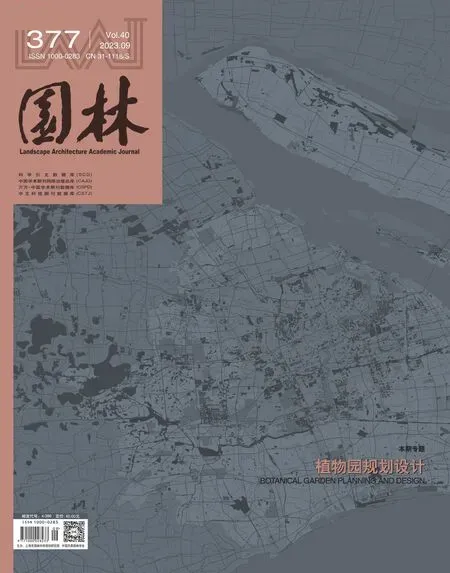高质量推进国家植物园体系建设
2023-09-25张浪
2022年4月18日,中国的国家植物园在北京揭牌,3个月后,华南国家植物园在广州揭牌。中国的国家植物园建设从1954年首次提出到2021年国务院批复同意,历时近70年。世界植物园的发展史,是一部人类加深认识植物、利用植物和保护植物的历史。目前有40多个国家设立了国家(皇家)植物园,特别是在生物多样性丰富的发展中国家和经济比较发达的欧美国家。相比之下,中国的国家植物园体系建设刚刚起步。2021年10月,在UN Biodiversity Conference COP15峰会上,习近平主席宣布启动国家植物园体系建设。2022年,国家林草局、住建部、中科院联合编制了《国家植物园体系建设规划(2022 - 2035年)》,在已设立两个国家植物园的基础上,综合考虑国家重大战略、主要气候类型与典型植被区划特点等因素,对国家植物园体系建设进行空间布局。
弗农·希尔顿·海伍德(Vernon Heywood)教授认为,中国的上林苑(公元前138年)是植物园的鼻祖。国际植物园协会将“一个向公众开放的、其内的植物挂有标牌的园地”作为对植物园的定义;国际植物保护组织(Botanic Gardens Conservation International,BGCI)对植物园的定义是“拥有活植物收集区,并对收集区内的植物进行记录管理,使之用于科学研究、保护、展示和教育的机构”。植物园定义的逐渐明晰,进一步表征了其功能属性,即不仅是生物多样性保护的基地,也是战略植物资源的储备库,同时兼顾植物科学传播的重要平台。围绕人文与自然、资源与保护、系统与专类、外貌与内涵等方面进行自主创新,是国家植物园的建设目标。国际上,常常把植物园建设水平看作是一个国家植物迁地保护水平的重要标志。现代意义的中国植物园建设也会以列入世界遗产的邱园、科斯滕布什国家植物园、基督城植物园、新加坡植物园等为标杆,在顶层布局规划、园区设计、科学普及、游览服务、运营管理、科学研究及国际交流各方面积极推进,开展国家植物园体系建设,以更好地应对气候变化、推进双碳实践、助力公园城市建设,从而向中国特色、世界一流、万物和谐的目标不断迈进。
本期专题“植物园规划设计”,围绕国内外植物园的发展脉络、分类规划、选址布局、科学管护而展开研讨。厘清了基于植物分类系统、产地、功能、服务对象、生境类型的5类植物专类园,及其在类型划分、主题选择、植物配置、发展模式方面的规划设计重点;剖析了知名国家植物园选址布局涉及的自然环境、人文环境、交通情况、未来发展空间,并基于城市、水资源、地貌、科研、经济实力等因素为国家植物园选址布局提供参考;针对气温上升、热带气旋、干旱洪涝三类当前全球面临的气候挑战,探讨了国外历史植物园的应对管理措施,提出国内植物园的科学可持续管理路径;分析了亨廷顿植物园、埃及植物园、巴基斯坦植物园等各具地域特征的植物园的发展脉络及对中国国家植物园体系建设的借鉴价值。
主编
2023年8月8日
Promoting the System Construction of National Botanical Garden with High Quality
On April 18, 2022, China’s National Botanical Garden was inaugurated in Beijing, and three months later, the South China National Botanical Garden was inaugurated in Guangzhou.The construction of China’s national botanical gardens has taken nearly 70 years, from its first proposal in 1954 to the State Council’s approval in 2021.The history of the development of botanical gardens in the world is a history of mankind’s deepening understanding of plants, utilization of plants and protection of plants.At present, more than 40 countries have set up national (royal) botanical gardens, especially in developing countries rich in biodiversity and in Europe and the United States, where the economy is more developed.In contrast, the construction of China’s national botanical garden system has just begun.In October 2021, at the UN Biodiversity Conference COP15 summit, President Xi Jinping announced the launch of the construction of a national botanical garden system.In 2022, the State Forestry and Grassland Administration, the Ministry of Housing and Construction,and the Chinese Academy of Sciences (CAS) jointly prepared theNationalBotanical GardenSystemConstructionPlan(2022-2035), which provides a spatial layout for the construction of the national botanical garden system based on the two national botanical gardens that have already been set up, and taking into account the factors such as the major national strategies, and the characteristics of major climatic types and typical vegetation zoning.
Prof.Vernon Heywood considers that the Shanglin Garden in China (138 BC) is the originator of botanical gardens.The International Association of Botanical Gardens defines a botanical garden as “A garden open to the public and in which the plants are labeled”; the Botanic Gardens Conservation International (BGCI) defines a botanic garden as “An organization that maintains a collection of living plants and manages the records of the plants in the collection for scientific research, conservation, display,and education”.The gradual clarification of the definition of botanical gardens further characterizes their functional attributes, i.e., not only as a base for biodiversity conservation, but also as a reserve of strategic plant resources, taking into account an important platform for the dissemination of plant sciences.It is the goal of the National Botanical Gardens to carry out independent innovations centering on humanities and nature, resources and conservation, systems and specialties, and appearance and connotation.Internationally, the level of botanical garden construction is often regarded as an important symbol of a country’s level of plant relocation and conservation.The construction of Chinese botanical gardens in the modern sense will also take Kew Gardens, Kirstenbosch National Botanical Gardens, Christchurch Botanical Gardens and Singapore Botanical Gardens, which are listed in the World Heritage List, as a benchmark, and will actively promote the construction of a national botanical garden system by actively advancing in the planning of the top-level layout, park design,popularization of science, excursion services, operation and management, scientific research, and international exchanges, so as to better cope with climate change and promote the practice of dual-carbon, To help the construction of park city, so as to move forward to the goal of Chinese characteristics, world-class, and harmony of all things.
This Topic of this issue “Botanical Garden Planning and Design”, focuses on the development of botanical gardens, classification and planning, site selection and layout, and scientific management and care at home and abroad.Based on the plant classification system, origin, function, service object and habitat type, the five types of botanical gardens and their planning and design focuses on type division, theme selection, plant configuration and development mode were clarified; The natural environment, humanistic environment, transportation and future development space involved in the site layout of the famous national botanical gardens were analyzed,and reference for the site layout of national botanical gardens was provided based on the factors of cities, water resources, geomorphology, scientific research and economic strength, etc.; For the site layout of the famous national botanical gardens, the planning of the national botanical gardens was discussed.Factors such as city, water resources, landscape, scientific research, economic strength, etc.were analyzed to provide references for the site layout of national botanical gardens.The development of Huntington Botanical Garden, Egyptian Botanical Garden, Pakistani Botanical Garden and other botanical gardens with regional characteristics and their reference value to China’s national botanical gardens were analyzed.
Editor-in-Chief
August 8th, 2023
